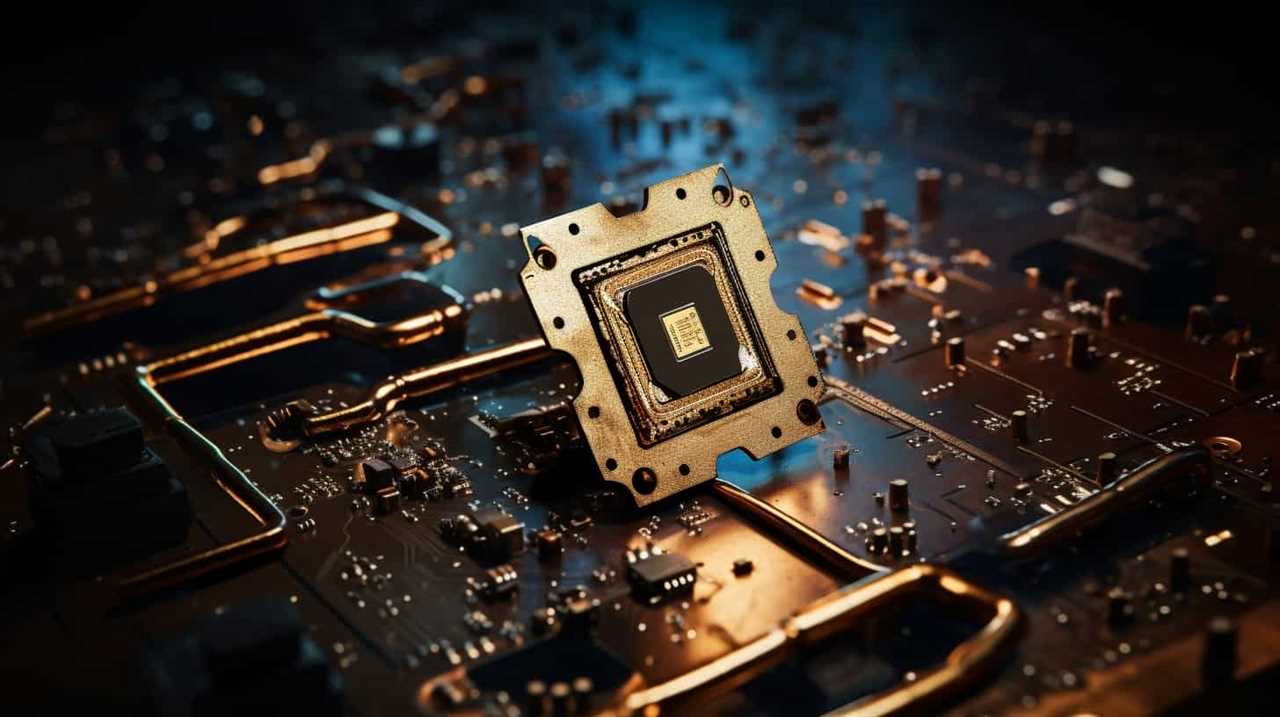Have you ever thought about who protects your online environment as a member of the internet community? Let me introduce AI security, the invisible protector in the digital world. With powerful algorithms and a proactive stance, AI can identify and stop cyber threats, bolster IoT devices, and improve authentication processes for users.
In this article, we will delve into the rising role of AI in cybersecurity, its implications for the future, and how it empowers us to master the art of digital protection.
Key Takeaways
- AI-powered threat intelligence revolutionizes the detection and response to cyber threats.
- AI actively secures IoT devices through advanced techniques and real-time monitoring.
- AI utilizes advanced techniques and real-time monitoring to enhance user authentication.
- AI security will continue to shape and redefine how we authenticate users and strengthen the security of digital assets.

The Rise of AI in Cybersecurity
In my experience, AI has emerged as a powerful tool in cybersecurity. With the increasing sophistication of cyber threats, organizations need advanced and proactive solutions to safeguard their digital assets.
AI powered threat intelligence has revolutionized the way we detect and respond to cyber threats. By analyzing vast amounts of data, AI algorithms can identify patterns, behaviors, and indicators of compromise that humans might miss. This enables us to stay one step ahead of attackers and mitigate potential risks.
AI driven anomaly detection plays a crucial role in identifying abnormal activities in real-time, allowing for immediate action. By leveraging the power of machine learning and deep learning, AI not only enhances our ability to detect cyber threats but also helps in preventing them.
In the next section, we’ll explore how AI detects and prevents cyber threats by diving deeper into its capabilities and methodologies.

How AI Detects and Prevents Cyber Threats
As an AI-powered tool, my ability to detect and prevent cyber threats is rooted in analyzing vast amounts of data and identifying patterns, behaviors, and indicators of compromise that humans might miss. Leveraging AI powered threat intelligence and machine learning in anomaly detection, I can effectively safeguard your digital world.
Here are three key ways in which I accomplish this:
- Real-time Monitoring: I continuously monitor network traffic, system logs, and user behavior, detecting any abnormal activities or deviations from the established baseline. This proactive approach allows me to identify potential threats before they can cause significant damage.
- Behavioral Analysis: By analyzing user behavior and network interactions, I can accurately identify anomalies and unusual patterns that may indicate malicious intent. This helps me differentiate between legitimate user activities and potential threats, enhancing threat detection capabilities.
- Threat Hunting: I constantly search for any signs of compromise or malicious activity within your digital environment. Through advanced algorithms and machine learning, I can identify known attack patterns and indicators of compromise, enabling timely detection and prevention of cyber threats.
With the power of AI, I provide a comprehensive and proactive defense against cyber threats, ensuring the security of your digital assets.

AI’s Role in Securing IoT Devices
AI actively secures IoT devices by employing advanced techniques and real-time monitoring. Machine learning plays a crucial role in IoT security, as it enables AI systems to learn and adapt to evolving threats. By analyzing vast amounts of data from IoT devices, AI can identify patterns and anomalies that may indicate a security breach.
Additionally, AI-powered vulnerability assessment tools can proactively identify potential weaknesses in IoT devices, helping to prevent attacks before they occur. These tools utilize AI algorithms to scan for vulnerabilities, prioritize risks, and recommend appropriate security measures.
With AI’s ability to continuously analyze and learn from data, IoT devices can be protected from emerging threats and vulnerabilities. This ensures the integrity and security of IoT networks, providing users with peace of mind.
Moving forward, let’s explore how AI enhances user authentication in the next section.

Enhancing User Authentication With AI
To enhance user authentication, AI utilizes advanced techniques and real-time monitoring. With the integration of biometric authentication and AI powered fraud detection, user authentication becomes more secure and reliable. Here are three ways AI enhances user authentication:
- Biometric authentication: AI algorithms can analyze unique physical or behavioral characteristics such as fingerprints, facial features, or voice patterns to verify a user’s identity. This eliminates the need for traditional passwords and provides a more convenient and robust authentication method.
- AI powered fraud detection: By leveraging machine learning algorithms, AI can detect patterns and anomalies in user behavior, detecting fraudulent activities in real-time. This proactive approach enhances security by identifying potential threats and preventing unauthorized access to sensitive information.
- Real-time monitoring: AI continuously monitors user activity, analyzing data from multiple sources to identify suspicious behavior. This allows for immediate action to be taken, such as triggering additional authentication steps or blocking access to prevent unauthorized access.
With AI’s advanced techniques and real-time monitoring, user authentication is strengthened, ensuring the security of digital assets and protecting against potential threats. As we look towards the future of AI security and its implications, these advancements will continue to shape and redefine how we authenticate users in the digital world.

The Future of AI Security and Its Implications
In the future of AI security and its implications, I envision a world where our digital assets are safeguarded by an unseen guardian.
As AI continues to advance, ethical considerations in AI security will become increasingly important. It will be crucial to ensure that AI systems are designed with privacy, transparency, and fairness in mind. This will require robust regulations and guidelines to govern the development and deployment of AI security solutions.
Furthermore, the government and defense sectors will heavily rely on AI security to protect critical infrastructure and sensitive information. AI-powered systems will play a pivotal role in detecting and mitigating cyber threats, ensuring national security. However, it’s imperative that the deployment of AI in these sectors be accompanied by stringent protocols and safeguards to prevent misuse and potential breaches.
The future of AI security holds immense potential, but it’s crucial that we address the ethical implications and implement appropriate measures to safeguard our digital world.

Frequently Asked Questions
What Are the Potential Risks and Vulnerabilities Associated With AI in Cybersecurity?
The potential risks and vulnerabilities associated with AI in cybersecurity include ethical implications and AI bias and discrimination. These issues must be actively addressed to ensure the security and fairness of our digital world.
How Does AI Technology Adapt to New and Evolving Cyber Threats?
AI technology adapts to new and evolving cyber threats through adaptive learning and real-time threat detection. It constantly analyzes and learns from data, allowing it to quickly identify and respond to emerging risks, ensuring the security of your digital world.
Can AI Effectively Protect AgAInst Sophisticated and Targeted Cyber Attacks?
Yes, AI can effectively protect against sophisticated and targeted cyber attacks. With its ability to analyze vast amounts of data and detect anomalies, AI plays a crucial role in defending against advanced threats and shaping the future of cybersecurity.
What Are the Limitations or Challenges of Using AI for Securing Iot Devices?
The limitations of using AI for securing IoT devices include compatibility issues with older devices and the ethical considerations of privacy and data collection. These challenges must be addressed to ensure effective protection.
How Does AI Enhance User Authentication and Ensure Privacy and Data Protection?
Enhancing user authentication and ensuring privacy and data protection are two areas where AI truly shines. By leveraging advanced algorithms, AI can detect fraudulent activities, provide robust security measures, and deliver a seamless and secure user experience.

Conclusion
In conclusion, AI security is revolutionizing the way we protect our digital world. With its advanced detection and prevention capabilities, AI is becoming an essential tool in the fight against cyber threats.
One interesting statistic is that a recent study found that AI-powered security systems can detect and respond to threats 60 times faster than traditional methods.
As technology continues to advance, AI security will play a crucial role in safeguarding our digital environments and ensuring a secure future.
Ava combines her extensive experience in the press industry with a profound understanding of artificial intelligence to deliver news stories that are not only timely but also deeply informed by the technological undercurrents shaping our world. Her keen eye for the societal impacts of AI innovations enables Press Report to provide nuanced coverage of technology-related developments, highlighting their broader implications for readers.










